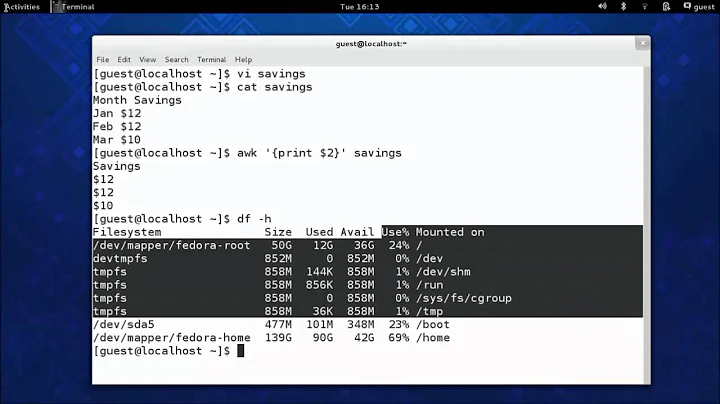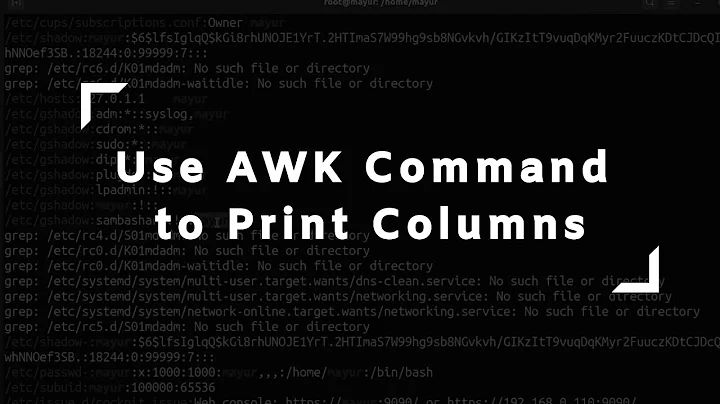How to remove a column or multiple columns from file using shell command?
Solution 1
Don't print 6th and 8th column
awk '{$6=$8=""; print $0}' file
Solution 2
This has been answered before elsewhere on Stack Overflow:
I believe awk is the best for that.
awk '{print $1,$2,$3,$4,$5,$7}' file
It is possible to use cut as well.
cut -f1,2,3,4,5,7 file
Solution 3
The best way to delete columns is with cut:
cut --complement -d' ' -f6,8 file
Explanation:
-
-dspecifies the delimiter; in this case, a space -
--complementkeeps the columns other than the ones specified in-f -
-fspecifies the columns to cut (rather than the columns to keep, since--complementis being used); in this case, columns 6 and 8
From the cut man page:
-d, --delimiter=DELIM use DELIM instead of TAB for field delimiter -f, --fields=LIST select only these fields; also print any line that contains no delimiter character, unless the -s option is specified --complement complement the set of selected bytes, characters or fields
Some others have proposed using a construction like awk '{$2=$4=""; print $0}', but this doesn't work in cases where the delimiter is something besides space; it makes the contents of the field the empty string, but does not remove the field altogether. For example, echo "a|b|c|d|e" | awk -v FS='|' -v OFS='|' '{$2=$4=""; print}' yields a||c||e.
Solution 4
Use printf to preserve the format of each field. Each field is x characters long and the minus sign justifies the string left.
awk '{ printf("%-8s %-8s %-8s %-8s %-8s %-4s\n", $1, $2, $3, $4, $5, $7)}' file
Solution 5
If you're open to a Perl solution...
perl -ane 'printf("%-8s %-8s %-8s %-8s %-8s %-4s\n", $F[0], $F[1], $F[2], $F[3], $F[4], $F[6])' file
These command-line options are used:
-nloop around every line of the input file, do not automatically print every line-aautosplit mode – split input lines into the @F array. Defaults to splitting on whitespace-eexecute the following perl code
Related videos on Youtube
Nainita
Updated on September 18, 2022Comments
-
 Nainita over 1 year
Nainita over 1 yearInput:
ARCHIVE B1_NAME B2_NAME B3_NAME ELEMENT INFO_NAM WERT PROCID -------- -------- -------- -------- -------- -------- ---- ------ 15MinAvg AIRSS 33-GIS DMDMGIS1 I MvAvr15m 1123 CP 15MinAvg AIRSS 33-GIS DMDMGIS1 P MvAvr15m 2344 CP 15MinAvg AIRSS 33-GIS DMDMGIS1 Q MvAvr15m 4545 CP 15MinAvg AIRSS 33-GIS DMDMGIS2 I MvAvr15m 6576 CP 15MinAvg AIRSS 33-GIS DMDMGIS2 P MvAvr15m 4355 CP 15MinAvg AIRSS 33-GIS DMDMGIS2 Q MvAvr15m 6664 CPOutput:
ARCHIVE B1_NAME B2_NAME B3_NAME ELEMENT WERT -------- -------- -------- -------- ------- ---- 15MinAvg AIRSS 33-GIS DMDMGIS1 I 1123 15MinAvg AIRSS 33-GIS DMDMGIS1 P 2344 15MinAvg AIRSS 33-GIS DMDMGIS1 Q 4545 15MinAvg AIRSS 33-GIS DMDMGIS2 I 6576 15MinAvg AIRSS 33-GIS DMDMGIS2 P 4355 15MinAvg AIRSS 33-GIS DMDMGIS2 Q 6664I want to delete the two columns
INFO_NAMandPROCIDfrom my input file. -
 Drav Sloan almost 9 yearsGive an example for
Drav Sloan almost 9 yearsGive an example forcut, or do not mention it? -
 Nainita over 8 yearsawk is working...... but whats happening... the format is changed.... its just taking the field but not the exact structure... and cut is not working... @AndreiR
Nainita over 8 yearsawk is working...... but whats happening... the format is changed.... its just taking the field but not the exact structure... and cut is not working... @AndreiR -
 Nainita over 8 yearsI have tried this,
Nainita over 8 yearsI have tried this,cut –c1-45,55-58. But before executing this I have to count the total characters then only I can us this. But I wanted to print the columns with the same as my input format -
 AndreiR over 8 years@Nainita maybe you have different separator that is not space. In awk you should specify it (i.e. using -F "\t" if tabular). Using cut, it is necessary to use -d (cut -d, if using comma).
AndreiR over 8 years@Nainita maybe you have different separator that is not space. In awk you should specify it (i.e. using -F "\t" if tabular). Using cut, it is necessary to use -d (cut -d, if using comma). -
 alhelal over 6 years@AndreiR
alhelal over 6 years@AndreiRcut -f1 filedoesn't work. see this image -
 AndreiR over 6 years@alhelal can you try cut -f 1 -d ' ' ?
AndreiR over 6 years@alhelal can you try cut -f 1 -d ' ' ? -
enharmonic over 3 yearsThis doesn't work in cases where the delimiter is something besides space; it makes the contents of the field the empty string, but does not remove the field altogether. See
echo "a|b|c|d|e" | awk -v FS='|' -v OFS='|' '{$2=$4=""; print}'yieldsa||c||e -
Yan Foto over 3 yearsBest answer: easy to understand, well explained!
-
 gented almost 3 yearsI don't understand why these answers with
gented almost 3 yearsI don't understand why these answers with$X=""are all over the place on SO: this does NOT omit the column, rather it sets them to the empty string whilst keeping the delimiters around. -
 Rick almost 3 yearsMacOS aka BSD doesn't seem to have
Rick almost 3 yearsMacOS aka BSD doesn't seem to have--compliement -
enharmonic almost 3 years@Rick see stackoverflow.com/questions/45851402/… for workaround using
brew install coreutilsandgcutin terminal. -
 Rick almost 3 yearsOk thanks I will take a look
Rick almost 3 yearsOk thanks I will take a look -
Johnny Utahh over 2 yearsfyi. the
cut-based answere below (and here: unix.stackexchange.com/a/615758/36362) works for me, on macOS 10.14.6 anyway. -
Johnny Utahh over 2 yearsWorks for me on macOS 10.14.6 with homebrew
coreutils.





